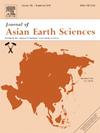华南大厂锡多金属矿田闪锌矿中铟的赋存与富集机理:第一部分——铜坑矿床
IF 2.7
3区 地球科学
Q2 GEOSCIENCES, MULTIDISCIPLINARY
引用次数: 0
摘要
铟是一种分散的、具有重要战略意义的元素,通常作为伴生元素存在于各种多金属矿床中。大厂矿田以其丰富的锡储量而闻名,还拥有重要的高品位铟资源。然而,铟在这一领域的赋存和富集机制尚不清楚。以广西大厂矿田铜坑锡多金属矿床为例,对上述问题进行了解析。根据不同的矿物组合,确定了3代闪锌矿(Sp1-Sp3)。Sp1主要与黄铜矿和方铅矿伴生,而Sp2主要与锡石和锡铁矿伴生。Sp3主要与锡石、黄铁矿共存。Sp1、Sp2和Sp3的平均In含量分别约为99、954和689 ppm。Sp1富集Fe、Cd、Pb和Bi, Sp2和Sp3富集in、Cu、Ga和Sn。铟可以通过In3+ + Cu+的替代↔2Zn2+和(In3+, Sn3+) + (Cu+, Ag+)↔2Zn2+而存在于闪锌矿中。在各代闪锌矿中,铜与In的富集表现出一致的正相关关系,而Ag和Sn的富集表现出代际差异。当Cd含量在0.35 ~ 0.45 wt%范围内时,闪锌矿的in含量显著增加,与“铟窗效应”一致。使用GGIMFis地温计,Sp1、Sp2和Sp3的地层温度分别为329 ~ 392℃、321 ~ 354℃和325 ~ 357℃。In含量与温度的关系表明,温度对In富集的影响与含量有关,应在特定的组成范围内进行评估。本文章由计算机程序翻译,如有差异,请以英文原文为准。

The occurrence and enrichment mechanism of indium in sphalerite from the Dachang Sn polymetallic ore field, South China: Part I. The Tongkeng deposit
Indium, a dispersed and strategically important element, typically exists as an associated element within various polymetallic deposits. The Dachang ore field, renowned for its substantial Sn reserves, also hosts significant high-grade In resources. However, the occurrences and enrichment mechanisms of In in this field remain unclear. The Tongkeng Sn polymetallic deposit of the Dachang ore field in Guangxi was chosen as an example to decipher the above issues. Three generations of sphalerite (Sp1-Sp3) were identified based on different mineral assemblages. Sp1 is mainly associated with chalcopyrite and galena, whereas Sp2 is always associated with cassiterite and stannite. Sp3 mainly coexists with cassiterite and pyrite. The average In contents of Sp1, Sp2, and Sp3 are about 99, 954 and 689 ppm, respectively. Sp1 is enriched in Fe, Cd, Pb, and Bi, while Sp2 and Sp3 are predominantly enriched in In, Cu, Ga, and Sn. Indium may be present in sphalerite via the substitution of In3+ + Cu+ ↔ 2Zn2+ and (In3+, Sn3+) + (Cu+, Ag+) ↔ 2Zn2+. Copper exhibits a consistent positive correlation with In enrichment across all sphalerite generations, while the effects of Ag and Sn show generation-specific variations. A significant increase in In content of sphalerite when Cd content ranges from 0.35 wt% to 0.45 wt%, consistent with the “Indium Window Effect”. Using the GGIMFis geothermometer, the formation temperatures for Sp1, Sp2, and Sp3 were estimated to be 329–392 °C, 321–354 °C, and 325–357 °C, respectively. The relationship between In content and temperature indicates that the effect of temperature on In enrichment is content-dependent and should be evaluated within specific compositional ranges.
求助全文
通过发布文献求助,成功后即可免费获取论文全文。
去求助
来源期刊

Journal of Asian Earth Sciences
地学-地球科学综合
CiteScore
5.90
自引率
10.00%
发文量
324
审稿时长
71 days
期刊介绍:
Journal of Asian Earth Sciences has an open access mirror journal Journal of Asian Earth Sciences: X, sharing the same aims and scope, editorial team, submission system and rigorous peer review.
The Journal of Asian Earth Sciences is an international interdisciplinary journal devoted to all aspects of research related to the solid Earth Sciences of Asia. The Journal publishes high quality, peer-reviewed scientific papers on the regional geology, tectonics, geochemistry and geophysics of Asia. It will be devoted primarily to research papers but short communications relating to new developments of broad interest, reviews and book reviews will also be included. Papers must have international appeal and should present work of more than local significance.
The scope includes deep processes of the Asian continent and its adjacent oceans; seismology and earthquakes; orogeny, magmatism, metamorphism and volcanism; growth, deformation and destruction of the Asian crust; crust-mantle interaction; evolution of life (early life, biostratigraphy, biogeography and mass-extinction); fluids, fluxes and reservoirs of mineral and energy resources; surface processes (weathering, erosion, transport and deposition of sediments) and resulting geomorphology; and the response of the Earth to global climate change as viewed within the Asian continent and surrounding oceans.
 求助内容:
求助内容: 应助结果提醒方式:
应助结果提醒方式:


